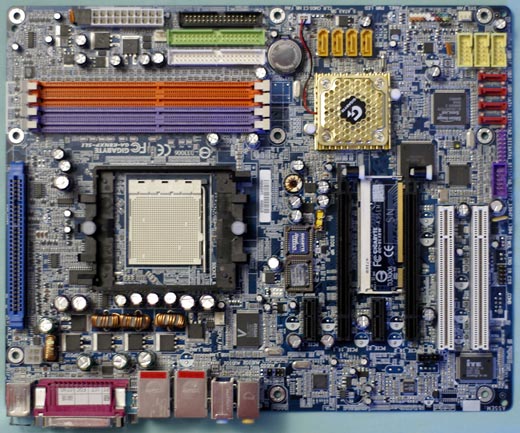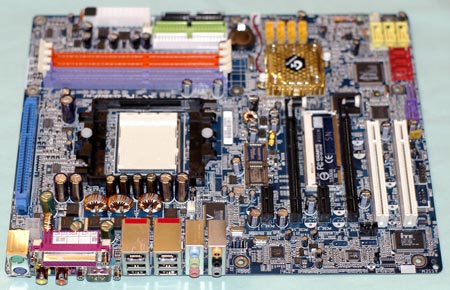nForce4 SLI Roundup: Painful and Rewarding
by Wesley Fink on February 28, 2005 7:00 AM EST- Posted in
- Motherboards
Gigabyte K8NXP-SLI: Features and Layout
| Specification | Gigabyte K8NXP-SLI |
| CPU Interface | Socket 939 Athlon 64 |
| Chipset | nForce4 SLI (single chip) |
| BUS Speeds | 200MHz to 400MHz (in 1MHz increments) |
| PCI/AGP Speeds | Asynchronous (Fixed) |
| PCI Speeds | 100MHz to 150MHz in 1MHz increments |
| Core Voltage | Auto, 0.80V to 1.75V in 0.025V increments |
| DRAM Voltage | Normal, +0.1V, +0.2V |
| Chipset Voltage | Normal, +0.1V, +0.2V, +0.3V |
| Hyper Transport Ratios | Auto, 1x to 5x in 1x increments |
| LDT Bus Transfer | 16/16, 16/8, 8/16, 8/8 |
| LDT Voltage | Normal, +0.1V, +0.2V, +0.3V |
| CPU Ratios | Auto, 4x to 25x in 0.5x increments |
| Cool'n'Quiet MAX FID | Auto, 8.0 to 13.0 in 0.5x increments |
| DRAM Speeds | Auto, 100, 133, 166, 200 |
| Memory Command Rate | Auto, 1T, 2T |
| Memory Slots | Four 184-pin DDR Dual-Channel Slots Unbuffered Memory to 4GB Total |
| Expansion Slots | 2 x16 PCIe Slots 2 x1 PCIe 2 PCI Slots |
| SLI Setup | Movable PCB Card |
| Onboard SATA | 4-Drive SATA 2 by nF4 PLUS 4-Drive SATA by Sil3114 |
| Onboard IDE | Two Standard nVidia ATA133/100/66 (4 drives) |
| SATA/IDE RAID | 4-Drive SATA 2 PLUS 4-Drive IDE (8 total) Can be combined in RAID 0, 1 PLUS 4-Drive SATA by Sil3114 Sil3114 Raid 0, 1, 5 |
| Onboard USB 2.0/IEEE-1394 | 10 USB 2.0 ports supported nF4 3 1394B FireWire 800 ports by TI chip |
| Onboard LAN | Dual Gigabit Ethernet PCIe by Vitesse VSC8201 PHY PCIe by Marvel 88E8053 |
| Onboard Audio | Realtek ALC850 8-Channel codec with 6 UAJ audio jacks, CD-in, front audio, and coaxial SPDIF In and Out |
| Other Features | Gigabyte Dual BIOS |
| BIOS | Award 2/01/2005 |
The shipping Gigabyte BIOS for the K8NXP-9/K8NXP-SLI family provides a wide and useful range of adjustments for many features, with the notable exception of a very limited range of memory voltage adjustments compared to other boards in the SLI roundup. As is the Gigabyte custom in recent designs, Advanced Chipset Features (and Memory Timings) can only be seen when you hot press CTRL+F1 while in the BIOS. HyperTransport adjustments are also provided in the hidden Advanced Chipset Features menu.
There are no BIOS options for adjusting or controlling SLI. This is handled in the nForce4 platform drivers and the nVidia graphics drivers.
The Gigabyte K8NXP-SLI, like the sister K8NXP-9, was designed as a top-of-the-line nForce4 motherboard. As the flagship model, it sports all the top Gigabyte features.


We are pleased that Gigabyte uses the nF4 on-chip Gigabit LAN by supporting it with a Vitesse (Cicada) Gigabit PHY. Gigabyte then goes one step further by including a second Gigabit LAN on the PCI Express Bus. This second LAN is also removed from the constraints of the slower PCI bus as it resides on the much faster PCIe bus.
Audio is AC '97 2.3, supported by the popular 8-channel Realtek ALC850. The K8NXP-SLI9 includes a wide range of audio I/O provided to make the most of the 850 chip. This includes 6 programmable audio mini-jacks and coax SPDIF in and out - all on the rear panel.
A pioneering feature for Gigabyte has been their support of high-speed 1394B Firewire on their boards. This continues with the K8NXP-SLI with 2 ports capable of 800MB/s or Firewire 800. This is double the speed of 1394A for those looking for fast Firewire access.
From a feature, board layout, and BIOS options point of view, the K8NXP-SLI can be considered the twin of the K8NXP-9. The only real change is the replacement of one PCI slot with a second PCIe video slot. All the good things about the features and layout of the K8NXP-9 are still here in the K8NXP-SLI.
DFI LANParty nF4 SLI-DR: Overclocking and Stress Testing
Gigabyte K8NXP-SLI: Overclocking and Stress Testing










108 Comments
View All Comments
Rike - Monday, February 28, 2005 - link
And then he double posts and can't spell "graphs." (not "graphes!") *bangs head on wall* Oh well. To err is human. Happy Monday! :)Wesley Fink - Monday, February 28, 2005 - link
#33 - That is correct, but to implement PCIe Ethernet the mfg must use a PHY gigabit ethernet controller. In fact, as I state in the review, all 4 SLI boards implement PCIe on Gigabit #1, but all 4 boards have dual gigabit ethernet. Most implement PCI on Gigabit #2 with the results you can see in the ethernet performance charts.#30 - It IS a significant point and I thought we were clear that the 3132 is PCIe. I will add that to the chart to removee any confusion. However, there is another side to MSI using PCIe on all the on-board features. With both PCIe LAN's and PCIe SATA2 add-on there are no channels left from the 20 lanes available for PCIe slots.
Rike - Monday, February 28, 2005 - link
Rike - Monday, February 28, 2005 - link
Minor typo: HL2 resolutions on the graphes are listed as 16,000 x 1200 instead of 1600 x 1200. Either that or you're using a seriously wide screen! ;)mechBgon - Monday, February 28, 2005 - link
Wes, an academic point: unless something's changed with nVidia southbridges, the nForce3/4 gigabit Ethernet controller isn't a PCI-based device, it's native to the southbridge and rides the Hypertransport bus. If you're getting >900Mbit/sec in your test, it's pretty obvious it's not on a 32-bit PCI bus ;)AlanStephens - Monday, February 28, 2005 - link
#28 - I know for a fact that Creative doesn't support Dolby Digital Encoding. I wish they did though. Here is a quote from Creative's Knowledge Basse on this:"Computer games written with support for 3D audio do not require a Dolby Digital Interactive Content Encoder (DICE) to output multichannel sound, with no exceptions. Sound devices that support the real time encoder technology from Dolby will simply receive the multichannel wave file output and encode it in real time to a somewhat modified Dolby Digital bitstream. Creative does not support the Dolby Digital Interactive Content Encoder on any of its sound cards.
The only difference between a Sound Blaster card and an audio card that has a real time encoder, is that you can make a one-wire, digital connection from your audio card to your home theater receiver and enjoy discrete multichannel sound from the game. However there will be a continuous, slight delay, known as "latency", as the encoder is creating and transmitting the bitstream, and of course the compression scheme being used is "lossy" (i.e. not bit-accurate).
If you want to enjoy 3D audio in 3D enabled PC games in multichannel surround sound with a Sound Blaster card, it is recommended that you connect the analog outputs of the sound card directly to the analog inputs of the receiver."
EODetroit - Monday, February 28, 2005 - link
I wanna know the answer to #28's question. I've been looking for the next Soundstorm... ie I want to output a dolby digital 5.1 (or better) signal through a spdif connection from a non-pre-encoded source, like only Soundstorm can.Can the MSI do this now too??
RyanVM - Monday, February 28, 2005 - link
Why didn't you guys bother to note that the Si3132 SATA controller is PCIe? I think that's a fairly significant point in comparison to the PCI Si3114 controller and it likely explains why the Si3132 was faster.Lakku - Monday, February 28, 2005 - link
I wish you would have discussed 6600GTs in more detail. I am perturbed at a number of sites saying the 6600GT is not worth it for SLI. Specifically from X-Bit (though many have echoed it) "We guess it is the 6600GT SLI configuration that's not very appropriate". The only fact for this statement is the lack of a 256MB 6600GT card. This means its high resolution on some games and FSAA capabilites are limited. But so what? Noone has discussed REAL WORLD prices of 6800GT and Ultra cards. They range from 430 to 800 dollars, for ONE card. Yet sites claim it's better to just get a 6800GT rather then two 6600GTs. I picked up my 6600GT for 170 bucks, brand new retail. It overclocked to 550/1100 easily and I kept it at that, even though it went quite a bit higher with air cooling. I put that in because it gave me another 5%-10% or so increase over stock speed. I could get two for just over 350, almost $100 cheaper, and in a majority of tests, it equals or BEATS a 6800GT. It only suffers when you get to 1600x1200 with FSAA, as its smaller frame buffer and 128-bit interface is a hinderance. But for such a HUGE price difference, is it not worth it? If I had bought two outright (my plan was to get a start on a PCIe based system to bring me up to date for the future, and then buy the next generation cards for SLI), I could use that extra 100 for the GF7600GT (I am assuming this name, and the fact that if the next generations are 24 pipes, then the mainstream will be 12) that when SLId, will be up there in terms of todays speed on 700 to 1000 dollar video combinations, all for under 400. The point is that I wish someone would actually take an IT type approach to this situation instead of badmouthing SLI or the price for running an SLI setup. You get SLI now, be cost effective and get 6600GTs, and you have a great platform for the next generation (if it still exists, but nVidia seems to have put its eggs in this basket so I assume it will be around for awhile) of cards that you can SLI and get great performance. Is SLI worth it? I say the answer SHOULD be a resounding yes if the same performance holds true for the future. It means you can always get two mainstream cards to equal ONE high end card, for a much cheaper price.chup - Monday, February 28, 2005 - link
Is the SB Live! 24 really capable of encoding audio stream into Dolby Digital stream?